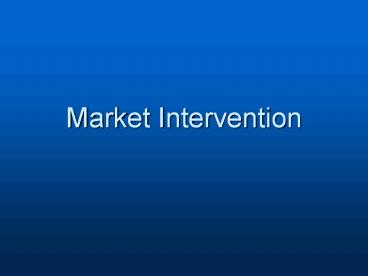Market Intervention - PowerPoint PPT Presentation
1 / 17
Title:
Market Intervention
Description:
Market Intervention Learning outcomes By studying this section students will be able to: evaluate the benefits of the free market evaluate the problems of the free ... – PowerPoint PPT presentation
Number of Views:144
Avg rating:3.0/5.0
Title: Market Intervention
1
Market Intervention
2
(No Transcript)
3
Learning outcomes
- By studying this section students will be able
to - evaluate the benefits of the free market
- evaluate the problems of the free market
- understand the methods of market intervention
- justify market intervention
- understand recent developments in public sector
provision
4
The free market
- The benefits of free markets
- the market knows best.
- economic efficiency
- Having maximum output for minimum input. Profit
maximization. - allocative efficiency
- Trade-off between producing one product, instead
of another? what product is best for firms?
5
The free market
- The benefits of free markets
- consumer sovereignty
- Demand of consumers leads more production in some
products. - economic growth
- Firms compete?productivity?better use of
resources?economic growth
6
The free market
- Criticisms of the market solution
- the inappropriateness of the perfect market
assumption - externalities
- Overproduced? Pollutions
- Violent Games? crime
- public goods
- Traffic lights//signposts for tourists
- realities of economic growth
- Ups and downs are normal in economic life cycle//
- No sustainability
- equity
- Having gap between the rich and the poor
- Those can access to resources( education) and
those who cant
7
Market intervention
- central planning
- Production decisions by government
(China/Singapore) - control of monopolies and mergers
- Control mergers,
- because mergers ? more monopoly
8
List of airline mergers and acquisitions
- Air West
- 1968 - Pacific Air Lines (originally Southwest
Airways), Bonanza Air Lines, and West Coast
Airlines merged to form Air West - 1970 - Howard Hughes purchased Air West and
renamed it Hughes Airwest - American Airlines
- 1987 - American Airlines purchased Air California
- 2001 - American Airlines purchased TWA
9
List of airline mergers and acquisitions
- Delta Air Lines
- 1924 - Started as Huff Daland Dusters
- 1928 - Huff Daland Dusters was purchased by C.E.
Woolman and renamed Delta Air Service after the
Mississippi Delta - 1953 - Purchased the Chicago and Southern Air
Lines, and flew under the name Delta CS for the
next two years - 1972 - Purchased Northeast Airlines
- 1987 - Merged with Western Airlines
- 1991 - Purchase of Pan Am's European routes, and
acquired Pan Am's shuttle, forming what is today
Delta Shuttle - 1991 - Purchased Eastern Airlines
- 1996 - Delta Express began service, ended
November 2003 - 2003 - Song began service, ended May 2006
- 2008 - Completed merger with Northwest Airlines.
Became the world's largest carrier by passenger
traffic (to keep Delta name)
10
List of airline mergers and acquisitions
- Northwest Airlines
- 1916 - Founded by Col. Lewis Patenaude, under the
name Northwest Airways - 1927 - Began flying passengers
- 1949 - With its new routes to the far east,
re-branded itself as Northwest Orient Airlines - 1986 - Purchased Republic Airlines, and dropped
the word Orient from its brand name - 2008 - Merged with Delta to form the world's
largest carrier. Currently a subsidiary of Delta
Air Lines, Inc. Combined carrier will use the
Delta name.
11
Market intervention
- laws, planning controls and permits
- Some goods and services may be banned.
- Additive drugs// prostitutions
- taxes and subsidies
- Taxes on luxurious products
- Subsidies on price of rice
- public provision
- Public ownerships of corporations
- Electricity Generating Authority of Thailand
- Metropolitan Waterworks Authority
12
Monopolies
- Are these passengers being ripped off?
- Probably
- Why?
- Many ferries operate in near-monopoly conditions.
So they may pay high prices for tickets and
certainly will for on-board catering
13
Problems of market intervention
- Resource allocation in disequilibrium
- Ineffective resource allocation by governments
- Can be heavily allocated in some areas (e.g. More
in big cities) - Public ownership efficiency and culture
- Leading to waste and poor quality of service
(mostly no competition) - Side-effects of subsidies and taxes
- Higher taxes? reducing incentives in economy
14
Problems of market intervention
- Loss of consumer sovereignty
- Power of consumers in spending is reduced by
income taxes. - Measurement of external (or social)costs and
benefits - Difficult to measure social cost
- Government interference and changing objectives
- Inconsistence in government policy.
- No more Kitchen of the world policy
15
Public or Private?
- What are the pros and cons of public ownership of
railways?
16
Trends in public sector provision
- Less central planning
- Even government needs to be more flexible and
competitive. - More privatization
- Should we privatize energy organizations?
- Performance targets and indicators
- Need to have clear and measurable targets and
indicators.
17
- The End































